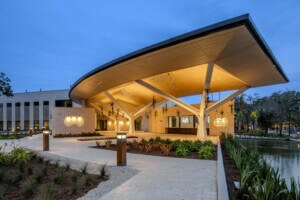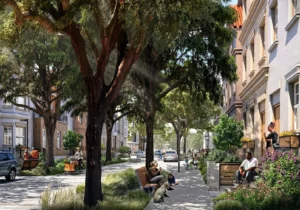In the early 1980s, a new time travel-themed attraction was unveiled at the Walt Disney World Resort in Florida. Like an oversized golf ball pelted straight from outer space to Orlando, Spaceship Earth is a fantastical fabrication. Its monolithic geodesic dome conceals two structures propped up by six steel legs, each driven some 160 feet into soft Floridian swampland below. Designed with the help of Ray Bradbury, Spaceship Earth continues to shuttle eager space tourists through an accelerated history of the world, where animatronic Neanderthals cozy up with ancient Greek charioteers and American astrophysicists under a swirling net of stars. In fifteen short minutes, the ride’s conveyor belt ascends through an abridged history of humanity that urges, after its namesake Buckminster Fuller, for a team effort to save our planet “Spaceship Earth.” It culminates in a future utopia that today’s passengers can customize via interactive screens and troubleshoot the world’s woes together in a group exercise.
Fast forwarding through a quarter-century of globalization and hyper-capitalist development, the $1.4 billion Jean Nouvel-designed Louvre Abu Dhabi and Apple’s $5 billion Silicon Valley campus by Foster + Partners have crafted a freakishly similar world of suspended disbelief and alter-reality. While they substitute the comparatively cheap thrill of Spaceship Earth’s 11,300 alucobond tiles with eight layers of steel and aluminum and some four miles of curved glass respectively, the Louvre Abu Dhabi and Apple Park are essentially designer circles. In their use of this sacred geometry, both projects become a sort of cosmic architecture, according to Craig Hodgetts, Principle of Hodgetts + Fung Architecture and Design.
“Nouvel’s sky-dome and the Apple headquarters rely on geometrically pure forms as a way to consolidate and insure a singularly unified experience,” suggests Hodgetts. “An absolute form, uncompromised, uninflected, unadorned, and too large to comprehend will lend a God-like authority to nearly any enterprise, and these structures assert the primacy of their makers rather than the profane delights of simple existence.”
Each “absolute form” depends on its God-like authority to extricate itself from its problematic social and political contexts–whether that’s occupying 175 acres of a California suburb currently suffering from one of the country’s worst housing shortages while refusing to engage with its urban planning efforts, or lodged inside a petrodollar-fueled arms race for global domination among oil-rich nations in the Gulf via Western cultural capital. Concealed beneath the all-consuming designs of Louvre’s bedazzled ceilings and Apple’s infinite rings of glass are both projects’ hidden, delirious desire to remove all context and weave their own origin stories–whether of mankind or Mackind.
Such grandiose narratives necessitate some serious cultural capital. Take, for instance, the UAE’s $900 million “loan” of the Louvre’s brand and expertise for the next 30 years, an agreement signed into place in 2007 which also authorized the borrowing of hundreds of French artworks from the collections of the Musée d’Orsay, Centre Pompidou, and Château de Versailles. Shrouded in mystery, this wholesale purchase included the expertise of a French curatorial committee which has reportedly advised the Emiratis to acquire almost 250 works thus far in assembling its own cultural history of the world, a collection that includes the record-breaking $450 million Da Vinci painting, Salvator Mundi, sold to an anonymous bidder at Christie’s last November.
Meanwhile, back in February 2017, Apple rebranded its sober “Campus 2” to “Apple Park”–emphasizing the OLIN-designed gardenscape, home to some 9,000 drought-resistant trees alongside other indigenous and imported flora (including its own apple orchard) that fills over half the site. With its hermetic green haven, Apple’s new campus indulges in a Land Before Time fantasy of Silicon Valley’s pre-tech ecology, intending to mimic California’s natural greenery before it was settled. It is a private garden of paradise viewable by Apple employees from all angles in Godlike omniscience.
“It’s not about maximizing the productivity of the office space, it’s about creating a symbolic center for this global company,” said Louise Mozingo, Chair of the Department of Landscape Architecture and Environmental Planning at U.C. Berkeley. “They are creating an icon.” Even without the figures–the only data most journalists have to work with until Apple lets down its impenetrable forcefield to visitors–it would be hard to make a case for the efficiency or efficacy of Ring’s 2.8-million square footprint. Built to house only 12,000 employees on its 175 acres, with nearly 11,000 commuting from outside Cupertino, the Park is a techno-utopian timewarp of California’s modernist-era abundance.
The campus also steers clear of Cupertino’s current public transit and housing shortages (the Bay Area added a reported 640,000 jobs between 2010 and 2015 while 75.8% of houses sold in 2017 for over $800,000). Instead, Apple taps into both collegiate spirit and corporate modernism, fabricating its design from a mix of Stanford’s quadrangles and the factory-like floor plans of the corporate campuses of the 50s and 60s favored by Foster. Apple justifies its inefficient use of 100 acres (offering more parking space than office space) with an origin story that waxes poetic on Steve Jobs’ first summer job at the now-razed Hewlett Packard Campus, which stood on this site in 1976, fresh from a summer picking apples on a commune in Oregon. Apple’s manifest destiny-like design narrative highlights the Park’s out-of-touch attitude towards its own conquest of valuable land in Cupertino, which could otherwise be used for affordable housing. Catering only to its inner circle of Apple acolytes, its “Spaceship” colloquialism feels particularly appropriate.
If these buildings are the result of resuscitated megastructure ideologies that superimpose their own fabricated mythology over contemporary geopolitics and ethics, what do their higher lifeforms look like? Childless, apparently, according to Apple Park. Despite a 100,000 square foot allowance for its fitness center, and 2-mile outdoor running track perfectly camouflaged from the roaring I-280 nearby, the workspace of the future miraculously lacks a daycare center for its 12,000 employees.
The Louvre Abu Dhabi’s ideal visitor doesn’t need superhuman smarts or a perfect body: he just needs to love the aesthetics of luxurious shopping malls. Beneath its latticed dome of 7,800 stars, in rooms of exotic marble and leather floors, visitors filter through seemingly endless and unordered rows of captionless artworks. Together, they form a utopian reimagining of human civilization that “turns a blind eye to a long history of human equality and exploitation,” suggests Javier Pes of artnet. But even without fingerprints to trace, the stated mission and ethos of the world’s “first universal museum,” praised by French and Emirati governments alike, has as many holes as its star-studded ceiling. Intended as an “antidote to the poison of hatred and barbarism” of culture wars in the Middle East, according to Louvre President Jean-Luc Martin, its starry-eyed humanitarianism clashes with the mass human rights violations committed against the Louvre Abu Dhabi’s migrant workforce, according to Al Jazeera, quoting French Director Benedicte Jeannerson of Human Rights Watch.
These world-structures manifest through the fantasy of a new world order that’s somehow eclipsed all conditions of crisis, operating on their own cultural capital of Instagrammability, as with the Louvre Abu Dhabi, or exclusivity, as with Apple Park, which still remains a highly coveted fortress-cum-tourist mecca over a year after its official press launch. The closest most of us will get to stepping inside the Jobs Mausoleum is a monthly subscription to new Youtube drone footage. But just as Apple Park’s designer landscaping and sprawling carpark can’t curb worldwide species extinction and rampant property inflation, the Louvre Abu Dhabi’s petrodollar-primed, marble-encrusted villages of culture can’t white-out the political turmoil surrounding the Gulf and the systemic abuse of its displaced workers.
If today’s conditions of global crisis can be considered a type of manmade gravity, then these structures aspire to grow so large that they might break free from this condition or create their own operating systems altogether. While looking to the stars for inspiration is all but human, we must eventually lower our gaze to the real implications of these projects and bring the God complex framing their hermetic existence back down to Earth.











